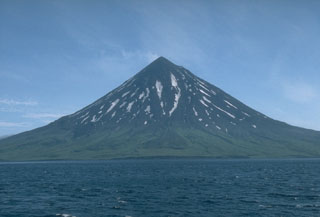Report on Cleveland (United States) — 19 April-25 April 2017
Smithsonian Institution / US Geological Survey
Weekly Volcanic Activity Report, 19 April-25 April 2017
Managing Editor: Sally Sennert.
Please cite this report as:
Global Volcanism Program, 2017. Report on Cleveland (United States) (Sennert, S, ed.). Weekly Volcanic Activity Report, 19 April-25 April 2017. Smithsonian Institution and US Geological Survey.
Cleveland
United States
52.825°N, 169.944°W; summit elev. 1730 m
All times are local (unless otherwise noted)
AVO reported that recent satellite images of Cleveland revealed that a lava dome has been extruded in the summit crater, with growth likely beginning after the last explosion on [24 March]. The Aviation Color Code was raised to Orange and the Volcano Alert Level was raised to Watch.
Slightly elevated surface temperatures were identified in satellite images over the past couple of weeks. The new dome was first visible in images on 15 April, with the presence of a small (less than 10 m diameter) mound deep in the crater. By 23 April this mound had grown to 45 m in diameter. Dome growth had occurred with no detectable seismicity.
Geological Summary. The beautifully symmetrical Mount Cleveland stratovolcano is situated at the western end of the uninhabited Chuginadak Island. It lies SE across Carlisle Pass strait from Carlisle volcano and NE across Chuginadak Pass strait from Herbert volcano. Joined to the rest of Chuginadak Island by a low isthmus, Cleveland is the highest of the Islands of the Four Mountains group and is one of the most active of the Aleutian Islands. The native name, Chuginadak, refers to the Aleut goddess of fire, who was thought to reside on the volcano. Numerous large lava flows descend the steep-sided flanks. It is possible that some 18th-to-19th century eruptions attributed to Carlisle should be ascribed to Cleveland (Miller et al., 1998). In 1944 it produced the only known fatality from an Aleutian eruption. Recent eruptions have been characterized by short-lived explosive ash emissions, at times accompanied by lava fountaining and lava flows down the flanks.
Source: US Geological Survey Alaska Volcano Observatory (AVO)

